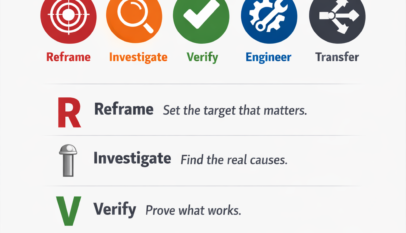Equipment reliability is at the heart of operational success in any maintenance department. Frequent breakdowns, understaffing, and the blame game between production and maintenance teams are all too familiar. However, by focusing on a few core ideas, you can significantly improve the uptime and reliability of your assets. Let’s dive into these actionable strategies that can make a huge impact on your maintenance operations.
Understanding the Root Issues
Maintenance managers often face recurring issues like frequent equipment breakdowns and limited maintenance personnel. Addressing these problems requires a proactive approach rather than a reactive one. Before diving into the solutions, it’s essential to identify the challenges you face daily. These might include:
- Frequent breakdowns with complex causes
- Short-staffed maintenance teams
- Preventive maintenance on equipment that still fails
- Constant blame from production when issues arise
Addressing these issues head-on involves looking beyond traditional practices and implementing strategic ideas that lead to sustainable improvements.
Idea 1: Improve Equipment Maintainability
The first step toward better reliability starts with making your equipment more maintainable. Focus on the most critical equipment and work closely with production management to identify machines that are in the worst condition but are crucial for operations. Here’s a simple roadmap to follow:
- Identify Critical Equipment: Collaborate with production to select the most critical equipment needing immediate attention.
- Plan Upgrades: Develop a comprehensive plan involving your crew and production team to upgrade the equipment.
- Use Available Techniques: Identify problems using various technologies and production data.
- Execute the Plan: Order parts, schedule work, and ensure that all repairs follow repeatable, high-quality procedures.
- Perform Quality Checks: Validate that the work was done according to specifications and standards.
- Post-Repair Monitoring: Use predictive maintenance and process data to monitor equipment performance post-repair.
- Create Accountability: Display a sign indicating the equipment’s maintainability, and track metrics such as Mean Time Between Failure (MTBF) to measure improvement.
This structured process not only improves reliability but also boosts collaboration between maintenance and production, leading to better long-term results.
Idea 2: Track Metrics to Measure Effectiveness
Tracking the right metrics is vital in understanding where you are and where you need to go. One effective metric is PM Compliance, but if your equipment still fails despite having a 98% PM Compliance rate, something is wrong. You need to dive deeper into the correlation between PM Labor Hours and Emergency Labor Hours.
Here’s what you can do:
- Track PM Compliance alongside emergency labor hours using a line graph. If the results are unsatisfactory, it may be time to revisit your preventive maintenance strategy.
- Measure PM effectiveness by analyzing whether your preventive tasks are actually preventing breakdowns or just ticking a box.
Having a clear view of these metrics helps you develop a more effective strategy and take the necessary steps to improve equipment reliability.
Idea 3: Implement Balanced Scorecards for Maintenance
Imagine driving without looking at your dashboard—risky, right? The same applies to maintenance operations. A balanced scorecard helps you keep an eye on the health of your maintenance program. Your scorecard should include key metrics like:
- PM Compliance
- Planned Work completion
- Scheduled Compliance
- Work Order closure rates
- Rework levels
- Maintenance costs
- Wrench Time percentage
By regularly monitoring these metrics, you can ensure that your maintenance processes are on track. The goal is to identify issues before they escalate and to create a more proactive maintenance culture.
Final Thoughts: Stay Focused, Take it Step-by-Step
When it comes to maintenance, don’t try to tackle everything at once. Start by addressing the most pressing issues, focus on continuous improvement, and remember that success lies in the details. By applying these three simple ideas—enhancing equipment maintainability, tracking the right metrics, and implementing balanced scorecards—you’ll create a more reliable, effective, and stress-free maintenance environment.


















